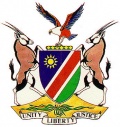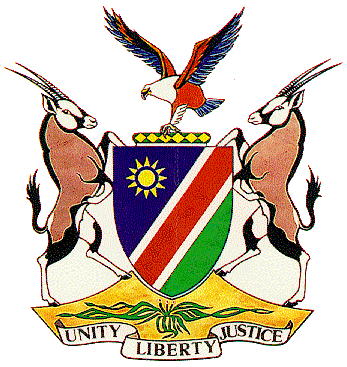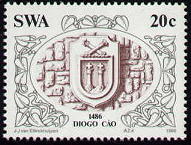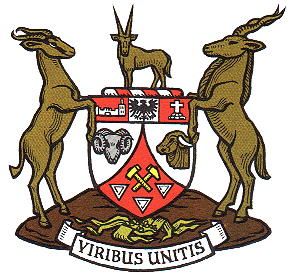National Arms of Namibia
Namibia heraldry portal
This page is part of the Namibia heraldry portal |
Heraldry of the World |
|
Civic heraldry:
|
Other heraldry: |
National Coat of arms of NAMIBIA
Official blazon
Arms: Tierced per bend sinister, Azure, Argent and Vert, a bend sinister Gules, and in dexter chief a sun with twelve straight rays Or, charged with an annulet Azure.
Crest: Upon a traditional head-ring Vert charged with six lozenges conjoined Or, a Fish Eagle rising, wings elevated and displayed, proper.
Supporters: Two Oryx proper.
Compartment: A Namib sand-dune with a Welwitschia mirabilis in the foreground, proper.
Motto: UNITY LIBERTY JUSTICE
Origin/meaning
The arms were officially granted on March 21, 1990.
The arms are based on the flag of Namibia, and are rooted in the sand of the Namib Desert. Rooted in the sand is the unique plant Welwitschia mirabilis, one of the worlds oldest plants, which may live for more than one century.
The fish eagle on the arms represents the north and the water resources of the country.
The two oryx are indigenous to the semi-arid parts of the country and are pride and brave animals.
The headband is made from diamonds, which are of importance to the economy of the country, and are placed in a traditional pattern.
The motto represents the key principles of the constitution of the country.
In November 1989 it was decided to create a flag and coat of arms for the new republic. As Namibia was scheduled to become independent on March 21, 1990, the time frame was relatively short. At first the flag was designed and it was decided that the arms were to be based on the flag. The public was invited to send in proposals for new arms, and 45 proposals were received. None of these, however, was acceptable for the committee dealing with the new arms. Finally the present arms were created, which shows elements from the flag as well as several local animals and the unique plant. As most of the population is of African descent it was decided not to use a helmet on the arms, but to use the eagle instead. The arms were officially approved by the committee on March 9th, and adopted in the first meeting of the new parliament on March 21st.
Even though the actual design, based on the flag, was approved by the committee without any problem, it was more difficult for the other elements. As supporters first two lions were proposed, being the 'king' of animals. However, heraldic lions are used in many different arms and lions are not specific for Namibia. Finally the oryx (gemsbok) was chosen, mainly because of its character, but also because oryx were the supporters of the arms of South-West Africa (see below). It was also proposed that the oxyx wore a collar made of diamonds and that they were placed on a Namib sand dune, similar as in the old arms.
The crest caused the biggest problems for the committee. It was soon decided not to choose a helmet, but some national symbol. Subsequently, all kinds of symbols were proposed : drums, gourds, hoes and all different kinds of utensils. However, most of these were closely related to one of the ethnic groups and thus were not suitable for the new country. Thus it was decided to use an indigenous animal instead. Complementary to the oryx, living in the dry south, the eagle was chosen for the wet north of the country. Instead of rising from a traditional wreath, a diamond wreath was proposed.
When, finally the arms were made and shown to the new President, he immediately agreed, except for the diamond collars. He did not expect oryx to run around with diamond collars.
Previous arms
The heraldic history of what is now Namibia starts at its discovery in 1485 by Diego Cão and the placement of a pillar with the Portuguese arms, a padrão , at Cape Cross, 120 km north of Swakopmund. The region was then more or less ignored by the Europeans until 1882 when the German trading company Lüderitz from Bremen acquired land south of Walvis Bay. This started the German colonisation of the area, which was renamed as Süd-West Afrika.
| The padrão as shown on a stamp from South West Africa. |
The Germans, unlike the British, did not use specific arms in their colonies, and consequently, only the German Imperial Arms were used. This changed in 1913 when a German official visited the colonies and noticed this difference with the British colonies. He thus went on to propose new arms for all German colonies. He proposed similar arms for all colonies, and for Deutsch Südwest-Afrika the arms showed the Prussian eagle over a bull's head and diamond, both golden on a blue field. Due to the start of the first World War and the surrender of the Germans in 1915, the arms were never actually used.
| The German arms for Deutsch Südwest-Afrika 1913-1915 |
In 1915 the area became the mandated territory under South African rule, known as South West Africa. At first the British Royal Arms were used, followed in 1919 by the South African Arms. The area followed the changes in the South African arms (see underSouth Africa) until 1960 when the territory finally received its own arms.
The first move towards arms for South West Africa started in 1958 when it was decided that the territory could have its own arms. After long discussions and several proposals the following arms were adopted:
| The arms of South West Africa (1960-1990). |
The arms show elements of nature, economy and history of the area. The bull's head and the Karakul ram represent the agriculture. The miner's tools obviously symbolise the riches in gold and diamonds. The latter emphasised by adding the diamonds. The upper part of the arms shows the German imperial eagle, the German fortress in Windhoek and the Portuguese padrão.
As supporters a kudu as an indigenous animal, and the springbok, South Africans national symbol were chosen. The oryx, as another indigenous animal was used as a crest. The shield was placed on a sand dune with the Welwitchia plant.
The arms were never officially granted, as South Africa was no longer part of the British Commonwealth, and the College of Arms in London could not grant the arms. The South African law did not allow to grant arms. Furthermore, South West Africa, even though it was considered a province by South Africa, officially was not part of South Africa. Similarly, when South Africa created its own State Heraldic Bureau, it had no legislative power over South West Africa. The legal battle continued for several years, in which also the design was often questioned. Especially the shape and appearance of the supporters was often debated. However, as the arms had been used in practice since 1960, the supporters were not changed. The arms finally were officially protected by law in 1964.
The arms were officially used until 1990, but due to political changes, there have been years when they have not been used at all.
As there were many colonial aspects in the arms, it was decided that the arms were not suitable for the arms of the new Namibia.
Use of the arms
| The arms on a coin from 1993 |
Contact and Support
Partners:
Your logo here ?
Contact us
© since 1995, Heraldry of the World, Ralf Hartemink 
Index of the site
Literature : Brownell; Merrington, both several papers.
















